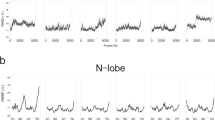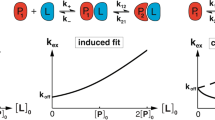Abstract
The physical basis for high-affinity interactions involving proteins is complex and potentially involves a range of energetic contributions. Among these are changes in protein conformational entropy, which cannot yet be reliably computed from molecular structures. We have recently used changes in conformational dynamics as a proxy for changes in conformational entropy of calmodulin upon association with domains from regulated proteins. The apparent change in conformational entropy was linearly related to the overall binding entropy. This view warrants a more quantitative foundation. Here we calibrate an 'entropy meter' using an experimental dynamical proxy based on NMR relaxation and show that changes in the conformational entropy of calmodulin are a significant component of the energetics of binding. Furthermore, the distribution of motion at the interface between the target domain and calmodulin is surprisingly noncomplementary. These observations promote modification of our understanding of the energetics of protein-ligand interactions.
This is a preview of subscription content, access via your institution
Access options
Subscribe to this journal
Receive 12 print issues and online access
$259.00 per year
only $21.58 per issue
Buy this article
- Purchase on Springer Link
- Instant access to full article PDF
Prices may be subject to local taxes which are calculated during checkout




Similar content being viewed by others
References
Wodak, S.J. & Janin, J. Structural basis of macromolecular recognition. Adv. Protein Chem. 61, 9–73 (2002).
Gilson, M.K., Given, J.A., Bush, B.L. & McCammon, J.A. The statistical-thermodynamic basis for computation of binding affinities: a critical review. Biophys. J. 72, 1047–1069 (1997).
Homans, S.W. Water, water everywhere—except where it matters? Drug Discov. Today 12, 534–539 (2007).
Tanford, C. The hydrophobic effect and the organization of living matter. Science 200, 1012–1018 (1978).
Sharp, K.A., Nicholls, A., Fine, R.F. & Honig, B. Reconciling the magnitude of the microscopic and macroscopic hydrophobic effects. Science 252, 106–109 (1991).
Chandler, D. Interfaces and the driving force of hydrophobic assembly. Nature 437, 640–647 (2005).
Steinberg, I.Z. & Scheraga, H.A. Entropy changes accompanying association reactions of proteins. J. Biol. Chem. 238, 172–181 (1963).
Karplus, M., Ichiye, T. & Pettitt, B.M. Configurational entropy of native proteins. Biophys. J. 52, 1083–1085 (1987).
Matthews, B.W. Genetic and structural analysis of the proteins stability problem. Biochemistry 26, 6885–6888 (1987).
Lee, A.L., Kinnear, S.A. & Wand, A.J. Redistribution and loss of side chain entropy upon formation of a calmodulin-peptide complex. Nat. Struct. Biol. 7, 72–77 (2000).
Frederick, K.K., Marlow, M.S., Valentine, K.G. & Wand, A.J. Conformational entropy in molecular recognition by proteins. Nature 448, 325–329 (2007).
Igumenova, T.I., Frederick, K.K. & Wand, A.J. Characterization of the fast dynamics of protein amino acid side chains using NMR relaxation in solution. Chem. Rev. 106, 1672–1699 (2006).
Li, Z., Raychaudhuri, S. & Wand, A.J. Insights into the local residual entropy of proteins provided by NMR relaxation. Protein Sci. 5, 2647–2650 (1996).
Kahl, C.R. & Means, A.R. Regulation of cell cycle progression by calcium/calmodulin-dependent pathways. Endocr. Rev. 24, 719–736 (2003).
Yap, K.L. et al. Calmodulin target database. J. Struct. Funct. Genomics 1, 8–14 (2000).
Muhandiram, D.R., Yamazaki, T., Sykes, B.D. & Kay, L.E. Measurement of 2H T1 and T1ρ relaxation-times in uniformly 13C-labeled and fractionally 2H-labeled proteins in solution. J. Am. Chem. Soc. 117, 11536–11544 (1995).
Marlow, M.S. & Wand, A.J. Conformational dynamics of calmodulin in complex with the calmodulin-dependent kinase kinase alpha calmodulin-binding domain. Biochemistry 45, 8732–8741 (2006).
Frederick, K.K., Kranz, J.K. & Wand, A.J. Characterization of the backbone and side chain dynamics of the CaM-CaMKIp complex reveals microscopic contributions to protein conformational entropy. Biochemistry 45, 9841–9848 (2006).
Lipari, G. & Szabo, A. Model-free approach to the interpretation of nuclear magnetic resonance relaxation in macromolecules. 1. Theory and range of validity. J. Am. Chem. Soc. 104, 4546–4559 (1982).
Frederick, K.K., Sharp, K.A., Warischalk, N. & Wand, A.J. Re-evaluation of the model-free analysis of fast internal motion in proteins using NMR relaxation. J. Phys. Chem. B 112, 12095–12103 (2008).
Crivici, A. & Ikura, M. Molecular and structural basis of target recognition by calmodulin. Annu. Rev. Biophys. Biomol. Struct. 24, 85–116 (1995).
Clackson, T. & Wells, J.A. A hot spot of binding energy in a hormone-receptor interface. Science 267, 383–386 (1995).
Lee, A.L., Sharp, K.A., Kranz, J.K., Song, X.J. & Wand, A.J. Temperature dependence of the internal dynamics of a calmodulin-peptide complex. Biochemistry 41, 13814–13825 (2002).
Palmer, A.G.I. & Massi, F. Characterization of the dynamics of biomacromolecules using rotating-frame spin relaxation NMR spectroscopy. Chem. Rev. 106, 1700–1719 (2006).
Kainosho, M. et al. Optimal isotope labelling for NMR protein structure determinations. Nature 440, 52–57 (2006).
Aoyagi, M., Arvai, A.S., Tainer, J.A. & Getzoff, E.D. Structural basis for endothelial nitric oxide synthase binding to calmodulin. EMBO J. 22, 766–775 (2003).
Meador, W.E., Means, A.R. & Quiocho, F.A. Target enzyme recognition by calmodulin: 2.4 A structure of a calmodulin-peptide complex. Science 257, 1251–1255 (1992).
Clapperton, J.A., Martin, S.R., Smerdon, S.J., Gamblin, S.J. & Bayley, P.M. Structure of the complex of calmodulin with the target sequence of calmodulin-dependent protein kinase I: studies of the kinase activation mechanism. Biochemistry 41, 14669–14679 (2002).
Osawa, M. et al. A novel target recognition revealed by calmodulin in complex with Ca2+-calmodulin-dependent kinase kinase. Nat. Struct. Biol. 6, 819–824 (1999).
D'Aquino, J.A. et al. The magnitude of the backbone conformational entropy change in protein folding. Proteins 25, 143–156 (1996).
Igumenova, T.I., Lee, A.L. & Wand, A.J. Backbone and side chain dynamics of mutant calmodulin-peptide complexes. Biochemistry 44, 12627–12639 (2005).
Gaboriaud, C., Bissery, V., Benchetrit, T. & Mornon, J.P. Hydrophobic cluster analysis: an efficient new way to compare and analyse amino acid sequences. FEBS Lett. 224, 149–155 (1987).
Marcus, Y. Ionic volumes in solution. Biophys. Chem. 124, 200–207 (2006).
Kranz, J.K., Flynn, P.F., Fuentes, E.J. & Wand, A.J. Dissection of the pathway of molecular recognition by calmodulin. Biochemistry 41, 2599–2608 (2002).
Balog, E. et al. Direct determination of vibrational density of states change on ligand binding to a protein. Phys. Rev. Lett. 93, 028103 (2004).
Bromberg, S. & Dill, K.A. Side-chain entropy and packing in proteins. Protein Sci. 3, 997–1009 (1994).
Ehrhardt, M.R., Urbauer, J.L. & Wand, A.J. The energetics and dynamics of molecular recognition by calmodulin. Biochemistry 34, 2731–2738 (1995).
Dyson, H.J. & Wright, P.E. Coupling of folding and binding for unstructured proteins. Curr. Opin. Struct. Biol. 12, 54–60 (2002).
Chatfield, D.C., Szabo, A. & Brooks, B.R. Molecular dynamics of staphylococcal nuclease: comparison of simulation with 15N and 13C NMR relaxation data. J. Am. Chem. Soc. 120, 5301–5311 (1998).
Prabhu, N.V., Lee, A.L., Wand, A.J. & Sharp, K.A. Dynamics and entropy of a calmodulin-peptide complex studied by NMR and molecular dynamics. Biochemistry 42, 562–570 (2003).
Showalter, S.A. & Brüschweiler, R. Validation of molecular dynamics simulations of biomolecules using NMR spin relaxation as benchmarks: application to the AMBER99SB force field. J. Chem. Theory Comput. 3, 961–975 (2007).
Li, D.W. & Brüschweiler, R. A dictionary for protein side-chain entropies from NMR order parameters. J. Am. Chem. Soc. 131, 7226–7227 (2009).
Zhang, F. & Brüschweiler, R. Contact model for the prediction of NMR N-H order parameters in globular proteins. J. Am. Chem. Soc. 124, 12654–12655 (2002).
Li, D.W. & Brüschweiler, R. In silico relationship between configurational entropy and soft degrees of freedom in proteins and peptides. Phys. Rev. Lett. 102, 118108 (2009).
Mobley, D.L. & Dill, K.A. Binding of small-molecular ligands to proteins: “What you see” is not always “What you get”. Structure 17, 489–498 (2009).
Kranz, J.K., Lee, E.K., Nairn, A.C. & Wand, A.J. A direct test of the reductionist approach to structural studies of calmodulin activity: relevance of peptide models of target proteins. J. Biol. Chem. 277, 16351–16354 (2002).
Dellwo, M.J. & Wand, A.J. Model-independent and model-dependent analysis of the global and internal dynamics of cyclosporine A. J. Am. Chem. Soc. 111, 4571–4578 (1989).
Skrynnikov, N.R., Mulder, F.A.A., Hon, B., Dahlquist, F.W. & Kay, L.E. Probing slow time scale dynamics at methyl-containing side chains in proteins by relaxation dispersion NMR measurements: application to methionine residues in a cavity mutant of T4 lysozyme. J. Am. Chem. Soc. 123, 4556–4566 (2001).
Collaborative Computational Project, Number 4. The CCP4 suite: programs for protein crystallography. Acta Crystallogr. D Biol. Crystallogr. 50, 760–763 (1994).
DeLano, W.L. The PyMOL Molecular Graphics System (DeLano Scientific, San Carlos, California, USA, 2002).
Acknowledgements
We are grateful to S. Bédard, A. Seitz and J.K. Kranz of the University of Pennsylvania for preparation of isotopically labeled smMLCK(p) peptide. We thank K. Sharp for helpful discussion. Financial support was provided by the US National Institutes of Health (DK 39806). K.K.F. acknowledges financial support from the US National Institutes of Health (GM 08275). J.D. acknowledges financial support from the Wenner-Gren Foundations.
Author information
Authors and Affiliations
Contributions
A.J.W. devised and initiated the project. M.S.M., J.D., K.G.V. and K.K.F. prepared the materials and collected and analyzed the primary data. M.S.M., J.D. and A.J.W. performed the analysis. A.J.W. wrote the manuscript.
Corresponding author
Ethics declarations
Competing interests
The authors declare no competing financial interests.
Supplementary information
Supplementary Text and Figures
Supplementary Figures 1 and 2, Supplementary Tables 1–7 (PDF 1621 kb)
Rights and permissions
About this article
Cite this article
Marlow, M., Dogan, J., Frederick, K. et al. The role of conformational entropy in molecular recognition by calmodulin. Nat Chem Biol 6, 352–358 (2010). https://doi.org/10.1038/nchembio.347
Received:
Accepted:
Published:
Issue Date:
DOI: https://doi.org/10.1038/nchembio.347
This article is cited by
-
Decoding the dual recognition mechanism of the glucocorticoid receptor for DNA and RNA: sequence versus shape
Scientific Reports (2023)
-
Protein conformational entropy is not slaved to water
Scientific Reports (2020)
-
The role of NMR in leveraging dynamics and entropy in drug design
Journal of Biomolecular NMR (2020)
-
Globally correlated conformational entropy underlies positive and negative cooperativity in a kinase’s enzymatic cycle
Nature Communications (2019)
-
Characterization of the dynamics and the conformational entropy in the binding between TAZ1 and CTAD-HIF-1α
Scientific Reports (2019)



